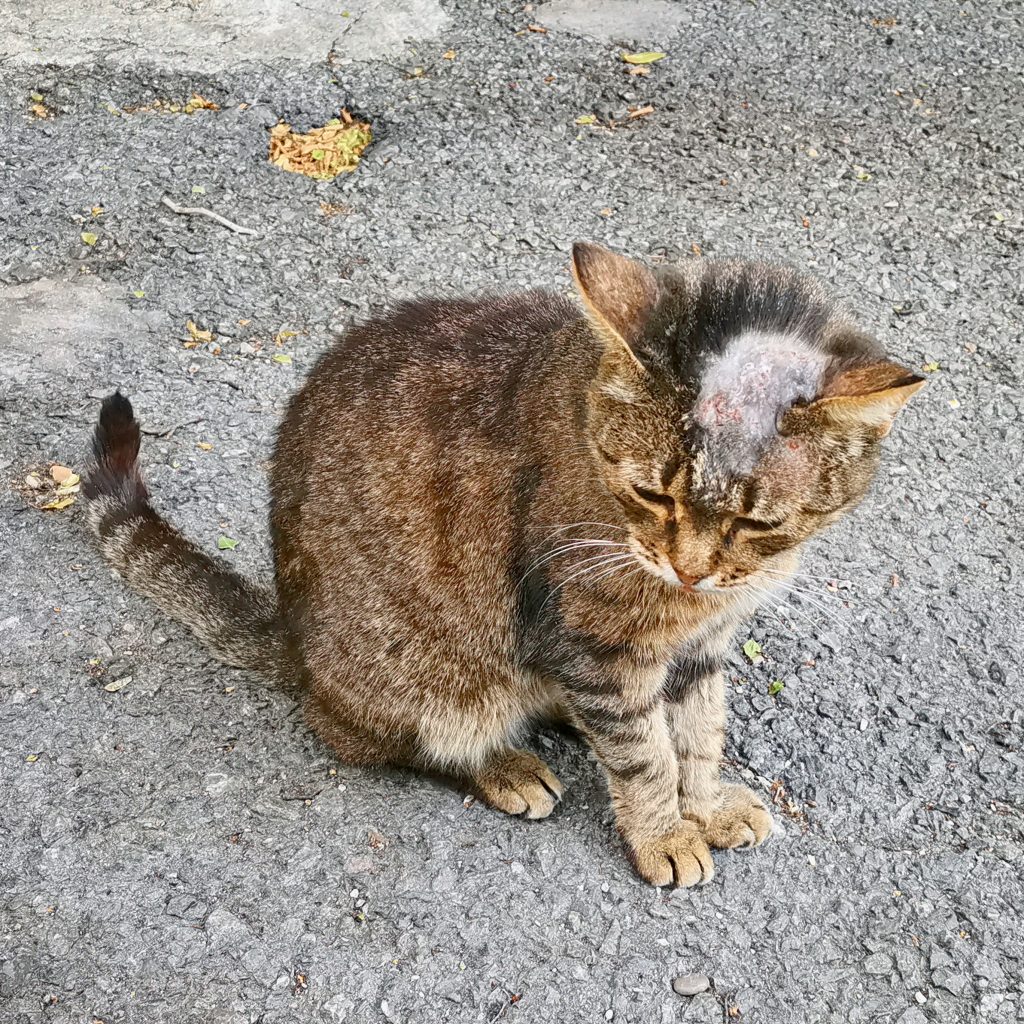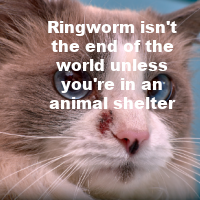By Jeffy the Journalist

Ringworm. The word strikes fear in the hearts of animal shelter staff and any human who lives with kitties (or pooches or kiddos). I can assure you, it’s never on the list we send to Santa Claws either.
Not a Worm
In the spirit of full disclosure, ringworm is a fungus among us. It got its name because of the round lesions that appear on the skin. No worm hitchhikers are involved. It’s not dangerous. It’s not the end of the world, except if you’re an animal in a shelter with it and they put you to sleep cuz they can’t adopt you out and you’re too much trouble. The truth is, it’s a pain in the tail, it’s contagious to other animals and people, but it’s self-limiting meaning it will go away on its own.
It’s generally a problem for young kittens and puppies, not so much in adult cats and dogs. Animals (meaning humans too) get it from infected animals. According to the paper, “Dermatophytosis,” by Dr. Karen A. Moriello of the University of Wisconsin at Madison (who has lots of letters behind her name), it’s in the soil, and rodents and other animals get it then pass it to larger animals. The most at-risk animals are those of us who live in groups (multipet homes, shelters, hoarders, and pet shops.)
The truth is, it’s not as easy to catch as humans think. Dr. M says a kitty (or pooch) has to be exposed to a large number of spores, our skin has to have moisture and the skin has to have microtrauma. That’s irritation or inflammation, like when we scratch or from wearing a collar. Dr. M says in labs it was hard to infect kitties with ringworm if they had healthy, undamaged skin.

Cleaning up the Environment
It’s actually not as contagious as old wives claim, and surprisingly, the environment isn’t very inefficient in infecting kitties (and pooches.) Dr. M says exposure to a contaminated environment most commonly results in a lesion-free infection, but it is a risk factor for sick animals or if they already have skin issues.
Kitties with ringworm may have little (or big) bald spots, redness, scaling and crusting. The spots are often round, but can also be asymmetrical. Although the fungus can affect anyplace on the body, it usually appears first on the face, ears, and paws. It may be hard to spot in longhaired animals. Whether a kitty (or pooch) gets one little spot or its widespread depends on the animal’s.
So you have a round spot on your fur. Is it ringworm, flea irritation or allergies? Your vet can take a culture.
Old wives tales and internet articles about ringworm often have all the credibility of cat poop.
Dr. M says, “Owners should be informed that [ringworm] is a non-life–threatening zoonotic disease that causes easily treatable skin lesions and be instructed to consult their personal physician if they have questions or suspect they may have skin lesions.”

In healthy animals, ringworm usually self-resolves in a month or two. Treating pets shortens the course of the outbreak and limits the transmission.
Ignore Bad Information
“Misinformation regarding cleaning, disinfection, and environmental contamination is pervasive,” Dr. M says. “Owners should be advised that fungal spores do not invade home surfaces as do other molds (eg, mildew), do not cause respiratory disease, and can be easily removed.”
Since ringworm usually pops up when animals are young and socialization and bonding are especially important, she says owners should continue to socialize and play with the infected pet, but wear gloves and washable clothing and avoid direct skin-to-skin contact. Wash hands (use soap and sing Happy Birthday). Give the kitten (or pooch) washable toys. Keep the infected four-legger away from other pets and avoid communal bowls, brushes and bedding. Dr. M says if you can’t keep critters separated, everyone can be bathed with a topical antifungal shampoo or treated with lime sulfur and watched closely for development of lesions.
The entire home interior doesn’t have to be torched. “If cleaning is regularly performed while the patient receives topical therapy, most homes can be decontaminated with one or two cleanings after cure.5””Anything you can wash in the washer or can be scrubbed can also be decontaminated.1
Make sure cat hair is vacuumed up every day. Clean stuff with paper towels or disposable cloths. Hard surfaces should be washed with detergent until visibly clean, then rinsed, dried, and sprayed with a disinfectant (such as products that contain accelerated hydrogen peroxide) kills ringworm.6 Believe it or not, bleach isn’t recommended cuz it’s an irritant, it damages surfaces, and it has no detergent properties. Who knew? Wash bedding twice with any laundry detergent on the longest wash cycle possible. Bleach and/or hot water aren’t superior to cold water without bleach. Agitation from the washing machine (not dryer heat) is antifungal. Carpets can be decontaminated by being washed with a beater-brush rug cleaner twice or steam cleaned once. Clean food dishes in hot, soapy water.
Your vet will tell the human the best way to treat you. It usually involves lots of unpleasant activities such as pilling, baths and yucky ointment. Humans should make sure to follow the vet’s instructions about shampoo dilutions cuz left on too long, some shampoos can cause skin irritation.
So if someone offers you a ring(worm) for Cat-mas remember, just say no. However, if you find a little red ring on your nose, it’s not for life and it doesn’t have to cost a life. Happy Holidays.
Source: Moriello, Karen A, DVM, University of Wisconsin–Madison. “Dermatophytosis.” Clinician’s Brief. August 2020.









